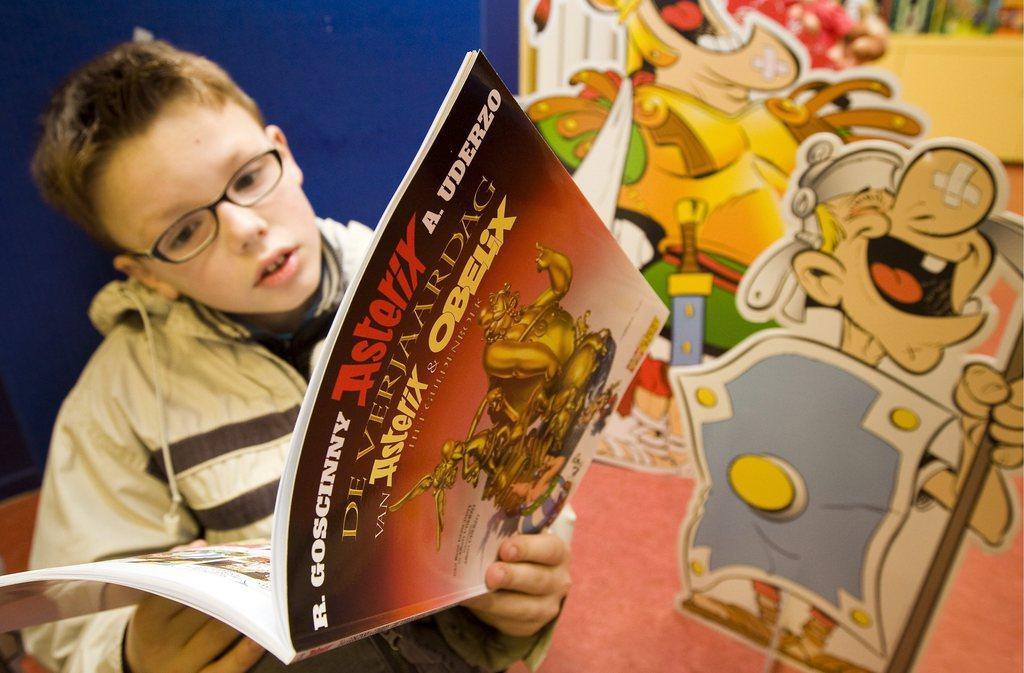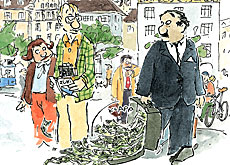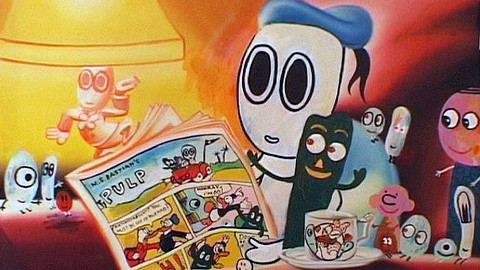How Asterix melted Swiss cheese and hearts

As cartoon hero Asterix hits 50, swissinfo.ch takes a nostalgic look at the plucky little Gaul's sojourn in Switzerland.
As expected, the 16th of 34 adventures pokes gentle fun at national stereotypes, from banking secrecy and an obsession with cleanliness to fondues and military service.
“You’d have to open an account,” a Geneva bank manager tells Asterix and sidekick Obelix, who have a cohort of Romans breathing down their necks. “What, to hide in a safe?” asks Asterix. “What you put in the safe is no concern of mine,” he replies. “Discretion is our watchword! You’ll just be two anonymous numbers to me. Will you take a safe each, or do you want a joint account?”
References like that – along with subtle gags on Swiss neutrality, William Tell and the Red Cross – would have whizzed over the heads of generations of schoolchildren, but the slapstick adventure and painstakingly crafted drawings make up for that.
Asterix, like The Simpsons, offers something for everybody – young or old, Swiss or Swedish, aware of in-jokes or culturally clueless.
Asterix has sold 325 million copies in 107 countries. More than 200 million of those were sold abroad, 110 million in Germany. The books are also big in the rest of Europe – especially Belgium.
The characters have reached an even wider audience through three live-action films, a theme park and the inevitable merchandising.
They never made it in the United States – an experiment at being serialised in newspapers came to an abrupt end. They are also practically unknown in Canada – although they remain very popular in Quebec.
The books have had success in various French-speaking countries, such as Algeria, but remain unknown in China and manga-loving Japan.
The hugely popular series, created by writer René Goscinny and illustrator Albert Uderzo, first appeared in the French comic journal Pilote in October 1959. Since then, Asterix and Obelix, two inseparable characters from a small village in Brittany, have spent their days resisting Caesar’s colonial ambitions.
They have suffered some hiccups along the way – most notably Goscinny’s death aged 51 from a heart attack in 1977 – but the mixture of adventure, satire and delicious puns have seen 325 million books sold in more than 100 languages.
Admittedly they failed to crack the United States, where comic book heroes were of the darker Marvel or DC variety. But the Gauls were never intended as a European copy of Superman or Batman, rather as a parody. They didn’t want to save the world – just their little village and their friends.
Immediate success
But in Switzerland – which has its own issues with what many citizens consider a surrounding imperial power – the books were an immediate hit.
“They were very popular – especially in the French-speaking part of the country obviously, because at first they were available only in French,” Pascal Siffert from La Bulle comic bookshop in Fribourg told swissinfo.ch.
“Also, French speakers read more comics than German speakers. Swiss Germans know hardly anything about comics, while the French-speaking Swiss have of course France and Belgium, where comics are a massive phenomenon.”
Asterix was in fact 11 when he and Obelix travelled to Switzerland, or Helvetia, in search of edelweiss (see box) in 1970.
“Asterix chez les Helvètes” was eventually translated into Switzerland’s three other national languages, with “Asterix e gli Elvezi” appearing in 1971, “Asterix bei den Schweizern” in 1973 and “Asterix ed ils Helvets” hitting Romansh shelves in 1984.
French humour
Some critics have argued that following the protests in Paris of May 1968, Goscinny started introducing more “adult” themes to the books.
Indeed “Asterix in Switzerland” opens with an orgy scene – a direct nod to Fellini’s Satyricon, which had come out in 1969 – and features one of the darkest plots, which focuses on preventing an innocent person from being murdered.
While unsure about the 1968 theory, Siffert says a watershed does exist.
“There’s an Asterix with Goscinny and an Asterix without Goscinny, in which the humour became a lot more lacklustre and the jokes and scenarios less interesting.”
Other critics agree that the books written by Uderzo are considerably weaker: Goscinny’s, they say, were art; Uderzo’s are children’s books.
“Goscinny was a writer without equal. Everything he touched – all the scenes he wrote – generally enjoyed great success. And this was well-deserved because he developed a certain sense of humour, slightly sarcastic but very French,” Siffert said.
“He had worked in the United States at the beginning of his career at Walt Disney, but he didn’t get very far because his sense of humour didn’t fit in at Disney. Then he discovered MAD [a US satirical magazine first published in 1952] and found he wasn’t the only person to have a sense of humour like that.”
Gained in translation
“[Goscinny] used many anachronisms with which he sent up our society via the Gauls and the Romans,” Siffert explained.
Some of his targets in “Asterix in Switzerland” include the recent introduction of motorway hotels (“chariotels”), the United Nations Geneva headquarters and the rows of hotels lining Lake Geneva.
Thanks to the fresh writing the book has aged well, although a Shylock-esque tax collector might raise a few eyebrows among more politically correct readers.
It must also be said that a large part of the series’ international success is down to the creative powers of the respective translators.
The English versions, all by Anthea Bell and Derek Hockridge, are acclaimed as translation masterpieces, successfully retaining Goscinny’s humour and often even improving on his punny names.
For example Idéfix (Obelix’s canine companion) became Dogmatix and Panoramix (the village druid) became Getafix. And how about the pair of legionaries called Sendervictorius and Appianglorius (a clue for non-British readers: God Save the Queen).
A hat tip also to the Italian translator who realised that Obelix’s catchphrase “These Romans are crazy!” could be rendered as “Sono pazzi questi Romani!”, i.e. SPQR, the Roman emblem…
“A good one”
So how does Siffert rate “Asterix in Switzerland” compared with the other books?
“I like it! It’s one of the good ones. Obviously as a Swiss I can laugh at the national stereotypes such as safes and cheese, mountains and yodelling and so on,” he said.
“Personally ‘Asterix in Corsica’ made me laugh a lot – I love that country and they nailed the Corsican mentality. But I think Asterix in Switzerland stands up well.”
Roman governor Varius Flavus has been embezzling taxes, sending only a pittance to Rome. When Quaestor Vexatius Sinusitus is sent to investigate, Flavus poisons him. Sinusitus sends for the druid Getafix, who can brew an antidote but needs an edelweiss, which only grows on the highest Alpine mountains.
Getafix sends Asterix and Obelix to Helvetia (Switzerland) to retrieve the flower and insists Sinusitus remain in their village as a hostage in order to guarantee Asterix and Obelix’s return. This is actually a ruse to get Sinusitus away from Flavus, who Getafix suspects is the would-be killer.
Asterix and Obelix reach Helvetia but soon run into difficulties set by the Romans, as Varius Flavus has warned his colleague in Helvetia of their arrival. But they manage to get help from some courageous Helvetians, including the hotel manager Petitsuix and Zurix the bank manager (Asterix and Obelix spend a night in one of his safes).
The two Gauls manage to secure an edelweiss and a few days later, Varius Flavus comes to the village and asks how Sinusitus is doing, dropping hints that he should be executed. But Asterix and Obelix have returned and Sinusitus confronts Flavus. He is cured, has consumed some magic potion (being the first, and so far, only Roman who has taken the potion without deceit) and punches Flavus into the sky. The story ends with the usual banquet, with Sinusitus being the first Roman ever to participate.

In compliance with the JTI standards
More: SWI swissinfo.ch certified by the Journalism Trust Initiative





You can find an overview of ongoing debates with our journalists here. Please join us!
If you want to start a conversation about a topic raised in this article or want to report factual errors, email us at english@swissinfo.ch.